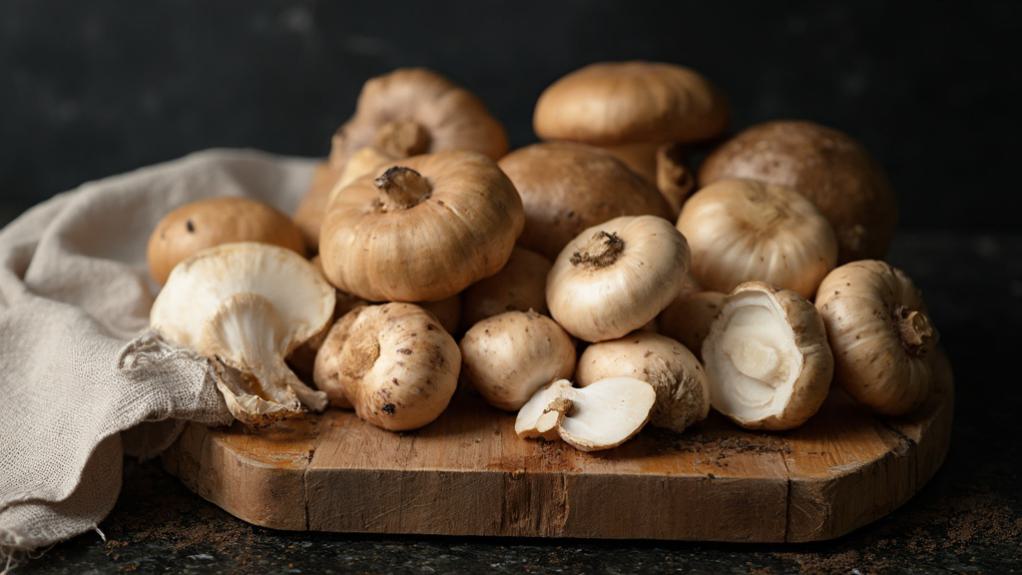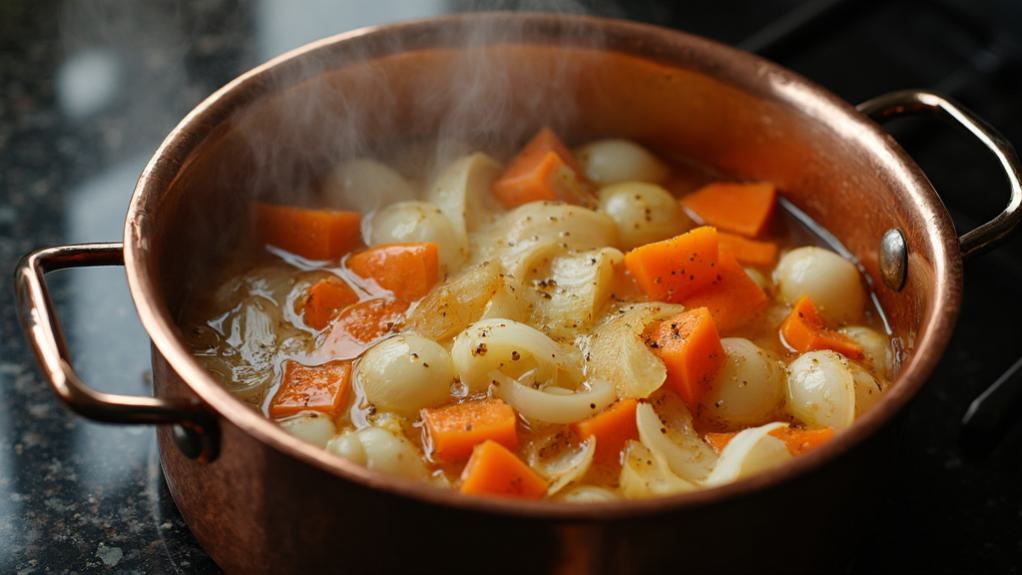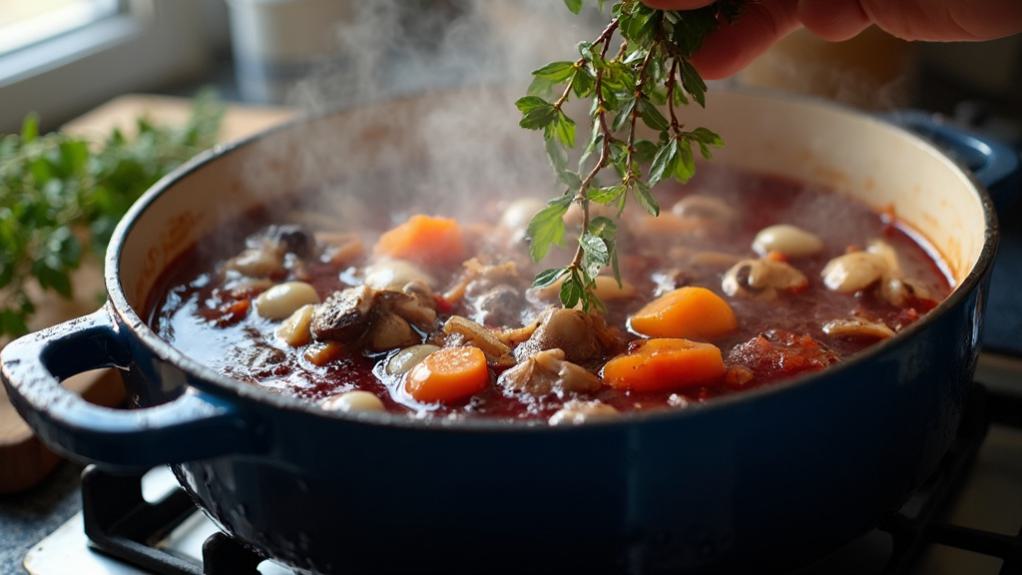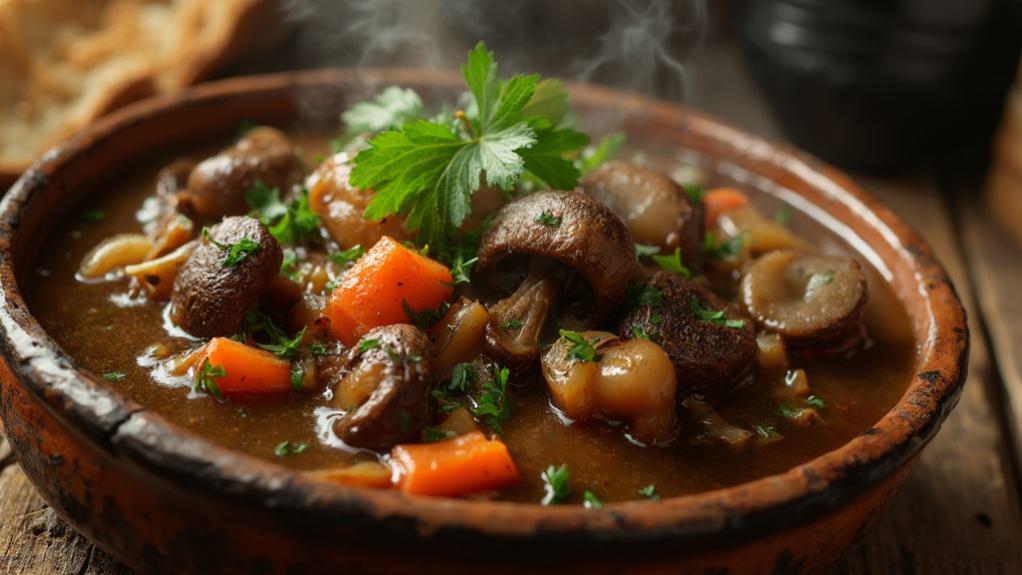Like a symphony of autumn colors dancing in a pot, I’ve discovered that Vegan Mushroom Bourguignon captures the essence of French cuisine without compromising my plant-based principles. I’m particularly drawn to the way this dish transforms humble mushrooms into something truly extraordinary – each bite carrying the depth and richness you’d expect from its traditional counterpart.
The process of creating this meal has become a meditative ritual in my kitchen, and I’ve perfected a few unexpected techniques that elevate it from good to sublime. Let me share how I’ve mastered this elegant yet rustic dish.
Recipe
This hearty vegan mushroom bourguignon transforms the classic French dish into a plant-based delight that captures all the rich, wine-infused flavors of the traditional recipe. The combination of different mushroom varieties creates a meaty texture while the slow-cooked vegetables and herbs develop a complex, satisfying flavor profile.
The secret to this dish lies in properly browning the mushrooms to develop a deep flavor base, then allowing the wine and vegetable broth to reduce into a thick, luxurious sauce. When served over mashed potatoes or crusty bread, this bourguignon delivers the same comfort and satisfaction as its meat-based counterpart.
- 2 lbs mixed mushrooms (cremini, shiitake, portobello), sliced
- 2 carrots, sliced diagonally
- 1 large onion, diced
- 4 garlic cloves, minced
- 2 cups pearl onions
- 2 cups red wine (vegan-certified)
- 2 cups vegetable broth
- 2 tablespoons tomato paste
- 1 tablespoon fresh thyme
- 2 bay leaves
- 3 tablespoons olive oil
- 2 tablespoons all-purpose flour
- Salt and pepper to taste
- Fresh parsley for garnish
Heat olive oil in a large pot over medium-high heat and cook mushrooms in batches until golden brown, about 5 minutes per batch, then set aside. In the same pot, sauté onions, carrots, and pearl onions for 8-10 minutes until softened.
Add garlic and cook for 1 minute, then stir in flour and tomato paste until well combined. Pour in wine and broth, add thyme and bay leaves, return mushrooms to the pot, and bring to a boil. Reduce heat, cover, and simmer for 45 minutes until sauce thickens.
Season with salt and pepper, garnish with parsley, and serve hot.
For the best results, select firm, fresh mushrooms and clean them with a damp cloth rather than washing them under running water, which can make them waterlogged. Use a good quality vegan red wine that you’d drink, as the flavor becomes concentrated during cooking.
The sauce can be adjusted by adding more broth if too thick or simmering longer if too thin. This dish actually improves in flavor when made a day ahead and reheated gently before serving.
Step-By-Step Cooking Instructions
You’ll want to start by gently cleaning your mushrooms with a damp cloth and slicing them into uniform pieces for even cooking.
Once your vegetables are prepped, you’ll create layers of flavor by sautéing them in batches in your pot, starting with the mushrooms and moving on to the onions, carrots, and garlic.
After adding your wine and broth to deglaze the pot, you’ll incorporate the herbs and let everything simmer together until the sauce becomes rich and velvety, finishing with a touch of salt and pepper before serving piping hot.
Step 1. Prepare and Clean Mushrooms

The proper preparation of mushrooms forms the foundation of a successful vegan bourguignon. You’ll want to start by carefully selecting your mushrooms, looking for firm specimens with clean, unblemished caps. Choose a mix of cremini for their meaty texture, shiitake for their rich umami flavor, and portobello for their substantial bite.
To clean your mushrooms, don’t rinse them under running water, as they’ll absorb too much moisture and become waterlogged. Instead, take a slightly damp paper towel or clean kitchen cloth and gently wipe each mushroom to remove any dirt.
Once clean, trim off the tough stem ends, particularly on the shiitakes. Slice larger mushrooms into thick, even pieces – about 1/4 inch for portobellos and 1/2 inch for creminis. Leave smaller mushrooms whole or halved to create textural variety in your dish.
You’ll want to handle the mushrooms gently to prevent bruising, and prepare them just before cooking to prevent oxidation. If you must slice them in advance, store them in a paper bag in the refrigerator, never plastic, which can trap moisture and lead to spoilage.
Step 2. Sauté Vegetables in Pot

Mastery of vegetable sautéing sets the stage for a rich and flavorful bourguignon. In your large pot over medium-high heat, drizzle two tablespoons of olive oil and wait until it’s shimmering.
Add your diced onions first, letting them turn translucent and slightly golden around the edges, which should take about 5-7 minutes.
Once your onions have softened, it’s time to add the diagonal-cut carrots and pearl onions to the mix. You’ll want to sauté these together for another 8-10 minutes, stirring occasionally to ensure even cooking.
Don’t rush this step – proper caramelization develops deep, complex flavors that’ll enhance your final dish.
Now, add your minced garlic and cook for just 30 seconds until fragrant – be careful not to let it brown.
Sprinkle the flour over your vegetables and add the tomato paste, stirring constantly to coat everything evenly. This roux will help thicken your sauce later.
You’re looking for the flour to cook just enough to lose its raw taste, about 1-2 minutes, before moving on to the next step.
Step 3. Add Wine and Broth

Pouring wine into the hot pot initiates a dramatic transformation of your dish, creating an instant sizzle and releasing aromatic steam.
You’ll want to add the wine gradually, stirring continuously to deglaze the pot and scrape up any browned bits stuck to the bottom – these contain concentrated flavors that’ll enrich your sauce.
Once the wine’s incorporated, pour in the vegetable broth while continuing to stir.
You’ll notice the liquid taking on a rich, burgundy color as it combines with the tomato paste and flour.
Don’t worry if it seems thin at first; it’ll reduce and thicken as it simmers.
Add your fresh thyme and bay leaves, letting them float freely in the liquid.
They’ll infuse the broth with their herbaceous notes during cooking.
Now’s the time to return your sautéed mushrooms to the pot.
Gently fold them into the wine-broth mixture until they’re evenly distributed.
You’ll want to bring the liquid to a gentle bubble, then reduce the heat to maintain a steady simmer.
Cover the pot, allowing the flavors to meld and the sauce to develop its characteristic richness.
Step 4. Add Herbs and Simmer

Delicate herbs dance through your bourguignon as you adjust the heat to maintain a gentle simmer. Add the fresh thyme leaves, letting them scatter across the wine-darkened surface, and drop in your bay leaves.
You’ll notice how the herbs immediately begin releasing their aromatic oils into the sauce, mingling with the earthy mushrooms and sweet pearl onions.
Cover the pot with a tight-fitting lid, but don’t forget to check occasionally to ensure your simmer doesn’t become too vigorous. You’re looking for tiny bubbles that lazily break the surface – not a rolling boil.
Over the next 45 minutes, you’ll witness a beautiful transformation as the sauce reduces and thickens, while the vegetables become tender and infused with flavor. The flour you added earlier will help create that signature silky texture that clings perfectly to each mushroom.
If you notice the sauce becoming too thick during this process, don’t hesitate to add a splash more vegetable broth.
Your patience will be rewarded as the herbs work their magic, creating layers of flavor that rival any traditional bourguignon.
Step 5. Season and Serve Hot

After those 45 minutes of patient simmering, your bourguignon has developed into a rich tapestry of flavors – now it’s time to perfect those final notes.
Remove the bay leaves, then taste your sauce and adjust the seasoning with salt and freshly cracked black pepper. You’ll want to be generous here, as the mushrooms have absorbed much of the initial seasoning during cooking.
Ladle your bourguignon into warmed serving bowls – presentation matters with this elegant dish. If you’re serving over mashed potatoes, create a generous well in the center to cradle the mushroom mixture. For crusty bread service, ensure each bowl has plenty of the rich sauce for soaking.
Scatter fresh parsley over each portion, letting the bright green herbs contrast with the deep burgundy sauce.
For a restaurant-worthy finish, drizzle a small amount of high-quality extra virgin olive oil over each bowl just before serving. This adds a subtle glossiness and fresh olive notes that elevate the final dish.
Serve immediately while the sauce is still steaming and the vegetables maintain their perfect tenderness.
Why I Love This Dish
This vegan mushroom bourguignon has won me over with its remarkable ability to transform humble ingredients into something truly extraordinary.
I’m constantly amazed by how the mushrooms develop such a rich, meaty texture while soaking up all those complex flavors from the wine and herbs. It’s become my go-to dish when I want to impress both vegan and non-vegan friends at dinner parties.
What I particularly love is how the sauce develops layers of flavor – from the caramelized mushrooms to the slow-cooked pearl onions and the concentrated wine reduction.
I’ve found that using different mushroom varieties creates an interesting interplay of textures, with some holding firm while others become delightfully tender.
The fact that it’s actually better the next day makes it perfect for my busy schedule; I’ll often make it ahead and reheat it when guests arrive.
There’s something deeply satisfying about creating such a classic French dish in a plant-based way that doesn’t compromise on taste or tradition.
It’s proof that vegan cooking can be just as sophisticated and satisfying as any traditional recipe.

Leave a Reply